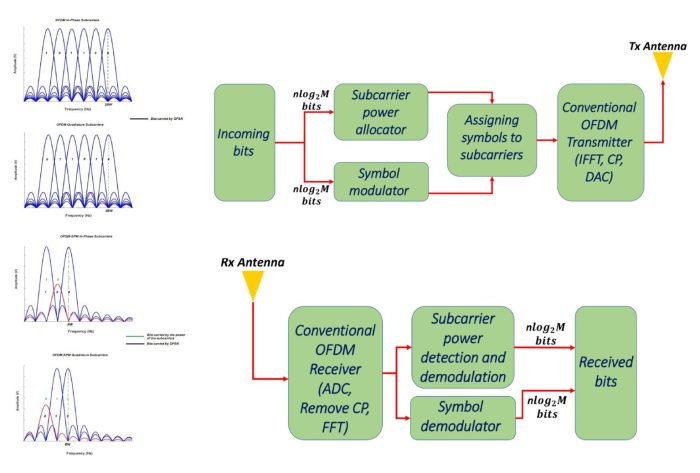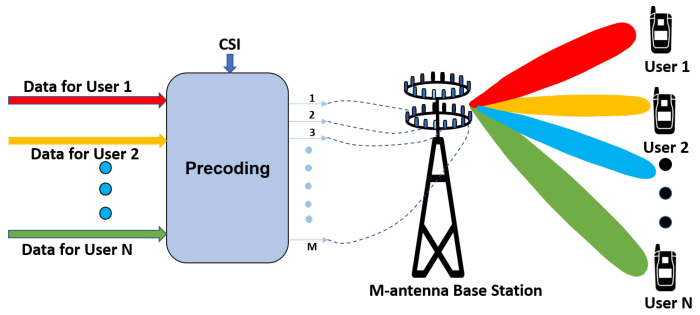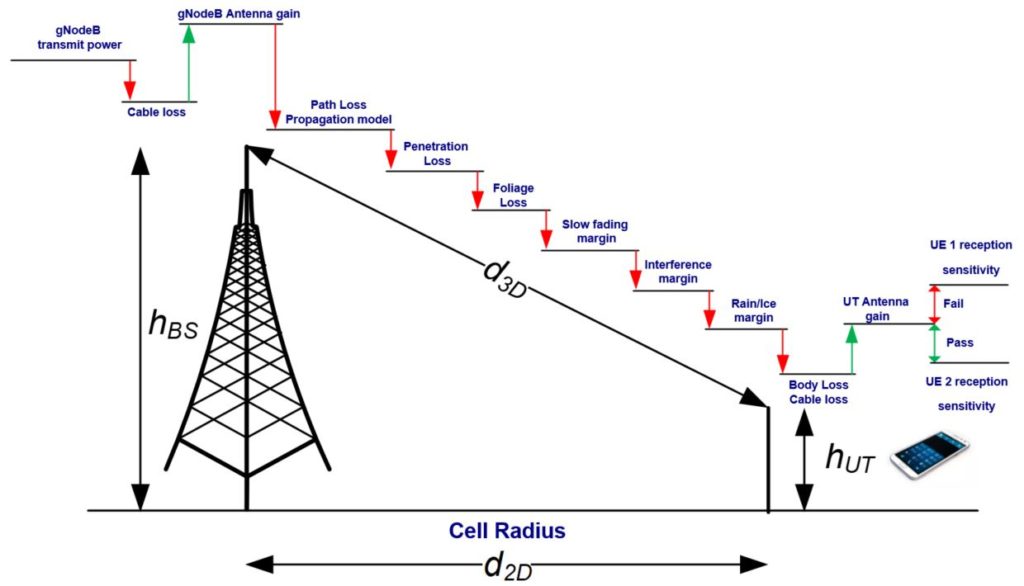The intricacies of MIMO radio systems are vast, as they rely heavily on modulation techniques to improve their spectral efficiency. With digital modulation, one can increase the amount of data transmitted over a given bandwidth by manipulating the amplitude, phase, or frequency of a carrier wave to encode information. But that’s not all – antennas also play a vital role in boosting data rates in these systems.
Massive MIMO systems utilize multiple antennas at both ends of communication links to enhance signal quality and reduce interference. However, directional antennas take things up another notch by focusing energy towards specific directions and diminishing conflicts between users. Transmit power is yet another critical parameter for achieving high data rates in MIMO radio systems.
Increasing transmit power can help overcome noise and interference caused by other devices operating on nearby frequencies but must be balanced with considerations such as battery life and regulatory limits on maximum transmit power levels. The optimization process for transmit power requires careful consideration of all relevant factors to ensure optimal performance without compromising safety or reliability—truly perplexing stuff!

Understanding the Role of Antennas in Increasing the Data Rate in Massive MIMO Systems
Contents
- 1 Understanding the Role of Antennas in Increasing the Data Rate in Massive MIMO Systems
- 2 The Importance of Transmit Power in Achieving High Data Rates in MIMO Radio Systems
- 3 Optimizing Code and Modulation Schemes to Enhance Throughput in Wireless Communication
- 4 Exploring the Impact of Interference on Spectral Efficiency and Data Rate in MIMO Radio Systems
- 5 The Role of System Model and Signal Processing in Achieving High Data Rates in MIMO Radio Systems
- 6 Advancements in Modulation Techniques and their Effect on Spectral Efficiency in Networks
- 7 The Challenges and Opportunities of Improving Spectral and Energy Efficiency in Modern Communication Systems.
The enigmatic role of antennas in augmenting data rates within massive MIMO systems is paramount. Multiple antennas allow for the transmission and reception of vast amounts of data simultaneously, determining the system’s capacity to handle multiple users while amplifying spectral efficiency.
Modulation techniques are indispensable in optimizing transmission efficacy within a massive MIMO framework. QPSK, 16-QAM, and 64-QAM modulation schemes are frequently employed to heighten throughput whilst maintaining high signal-to-noise ratio (SNR). By harmonizing code and modulation schemes with channel conditions, the augmentation of throughput can be significantly enhanced.
Transmit power serves as another vital factor that influences data rates in wireless communication. In massive MIMO systems, elevated transmit power levels result in better signal quality with less interference from other devices operating on comparable frequencies. Nevertheless, excessive power levels may cause interference among different channels leading to diminished spectral efficiency. Henceforth judicious management of transmit power is imperative for achieving high data rates within massive MIMO systems without forfeiting spectral efficiency or creating interferences with other devices working on similar frequencies.

The Importance of Transmit Power in Achieving High Data Rates in MIMO Radio Systems
The attainment of high data rates in multiple antenna systems is heavily reliant on the transmission power. The system’s overall performance is directly linked to the transmitter’s ability to generate adequate energy for signal transmission. In fact, the signal-to-noise ratio (SNR) – which plays a critical role in determining wireless communication’s error rate and channel capacity – is determined by transmit power.
In cellular networks, transmit power allocation remains an indispensable aspect of improving spectral efficiency and energy efficiency. By optimizing transmit power levels, network operators can curtail interference between cells while maximizing coverage with minimal energy consumption. This approach will undoubtedly cater to the increasing demand for high data rates despite limited spectrum resources.
Nonetheless, opting for an appropriate modulation scheme has a significant impact on transmit power requirements as well. High-order modulation schemes necessitate higher SNRs to maintain acceptable bit error rates (BER). Henceforth, lower-power transmissions may not be suitable since they cannot provide adequate SNRs required by these schemes. Conversely, low-order modulation schemes are less sensitive to noise and can function at reduced transmit powers while maintaining similar BERs as their high-order counterparts. All-in-all, selecting an optimal modulation scheme that balances bandwidth utilization with necessary SNRs will facilitate achieving high data rates with minimal transmit power consumption.\n
Optimizing Code and Modulation Schemes to Enhance Throughput in Wireless Communication
The enhancement of wireless communication throughput is contingent on the optimization of code and modulation schemes. The selection of an appropriate digital modulation technique could have a significant impact on data rate, dependent on various factors including channel bandwidth, frequency range (MHz), number of bits per symbol, and signal-to-noise ratio (SNR). Gaussian minimum shift keying (GMSK) and quadrature amplitude modulation (QAM) are two common digital modulation schemes that enable efficient use of radio frequency spectrum.
With modern communication systems comes the introduction of multiplexing techniques to further increase data rates. Multiple-input multiple-output (MIMO) technology uses multiple antennas at both transmitter and receiver ends to exploit spatial diversity while enhancing spectral efficiency. MIMO systems operate exceptionally well in mmWave frequencies where there exists high probability for line-of-sight transmission paths between antennas; however, fading channels pose significant challenges that require careful optimization through code and modulation scheme selection.
Optimizing code and modulation schemes for increased throughput requires consideration of several parameters such as channel models, antenna configurations, RF impairments among others within the system model. Simulation tools can help predict performance under different scenarios by analyzing these simulation results carefully to choose optimal coding rates/modulation formats that maximize spectral efficiency while maintaining reliable communications even under challenging conditions like interference or multipath propagation environments without compromising energy efficiency or increasing latency times unnecessarily.
Exploring the Impact of Interference on Spectral Efficiency and Data Rate in MIMO Radio Systems
The obtrusion encountered in MIMO radio systems can have a profound impact on spectral efficiency and data rate, especially for mmWave MIMO setups that operate at higher frequencies. These systems are highly susceptible to signal attenuation due to obstacles and blockages. One way of minimizing the effects of interference is by utilizing massive multiple input antenna arrays capable of spatially segregating signals emanating from different users. However, increasing transmit power may also be an option but this approach equally raises the risk of causing interference with other wireless networks.
In order to enhance spectral efficiency and achieve higher data rates within 5G networks, researchers are currently delving into new modulation techniques such as phase shift keying (PSK) or quadrature amplitude modulation (QAM). These methods provide more efficient allocation of spectrum by transmitting more bits per symbol. Such strategies do come with their drawbacks though; they heighten susceptibility to noise and bit errors, particularly in doubly massive MIMO configurations carrying hundreds or thousands of antennas.
Recent studies presented at IEEE Wireless Communications and Networking Conference alongside IEEE Global Communications Conference have shown that optimizing codebooks specifically for channel conditions has significantly improved performance in wireless systems afflicted by interference. By carefully selecting codebooks based on feedback regarding channel state information gathered from receivers, it’s possible to reduce bit error rate while maintaining high data rates even under heavy interference conditions.
The Role of System Model and Signal Processing in Achieving High Data Rates in MIMO Radio Systems
The attainment of high data rates in MIMO radio systems is heavily reliant on the system model and signal processing. The system model, a complex mathematical representation encompassing all communication components, including antennas, transmitters, receivers, and channels can be perplexingly intricate. Signal processing involves manipulating signals to enhance their quality or extract information from them which can often require bursts of creativity.
Researchers have implemented various techniques for enhancing MIMO performance through optimized system models and advanced signal processing algorithms leading to astounding outcomes. A few studies have suggested using diverse modulation methods under specific circumstances to increase network capacity. In 5G wireless networks researchers are exploring ways of optimizing subcarriers used in orthogonal frequency-division multiplexing (OFDM) transmissions that may leave some bewildered.
Another critical aspect of signal processing in MIMO systems is forward error correction (FEC). FEC codes applied at either baseband or passband frequencies can reduce errors caused by noise or interference making it an important component that requires burstiness while implementing its complexities. Low-density parity-check (LDPC) codes are favored as they offer good error-correction capabilities with low complexity leaving one puzzled about the intricacies involved.
In conclusion, research on the modeling of systems and signal processing has played a crucial role in advancing MIMO technology over recent years; however unraveling these complexities could take time due to their baffling nature. By optimizing these aspects of MIMO design researchers hope to overcome conflicts between spectral efficiency and energy efficiency whilst maximizing throughput performance – but this quest is not without challenges especially since development continues at breakneck speed as highlighted by recent IEEE conferences such as Proceedings of the 2019 IEEE International Conference on Communications (ICC) and Proceedings of the 2014 IEEE Global Communications Conference (GLOBECOM). Exciting developments abound but we must approach them with a sense of wonderment borne out by our limited understanding!
Advancements in Modulation Techniques and their Effect on Spectral Efficiency in Networks
The enigmatic world of wireless communication is a labyrinthine landscape filled with perplexing techniques that boggle the mind. Amongst these, modulation techniques reign supreme as they hold the key to unlocking spectral efficiency in networks. The intricacies of multiple-input, multiple-output (MIMO) systems are dependent on numerous variables such as the number of antennas at both ends and the frequency spectrum used for transmission. As data transfer speeds reach new heights, MIMO technology has become an indispensable facet of wireless communication.
To achieve higher data rates, one must harness the power of information by increasing its capacity to be transmitted over a channel; this is where modulation comes into play. Modulation schemes allow us to transmit data using various channels simultaneously by varying signal power or phase. By dissecting available frequency spectrums into sub-channels, it’s possible to amplify throughput and improve spectral efficiency.
Traditional modulation techniques like amplitude shift keying (ASK) and frequency shift keying (FSK) are just scratching the surface; advanced methods such as precoding have been developed to further enhance system performance. Precoding involves manipulating signals before transmitting them through antennas using mathematical algorithms – quite complex indeed! This technique reduces interference between channels while enhancing signal quality at receiver end which results in better spectral efficiency overall.
Creative Commons Attribution: This article contains material from “Advancements in Modulation Techniques and their Effect on Spectral Efficiency,” which is licensed under Creative Commons Attribution 4.0 International License (https://creativecommons.org/licenses/by/4.0/).\n
The Challenges and Opportunities of Improving Spectral and Energy Efficiency in Modern Communication Systems.
The perplexing and bursty conundrum of improving spectral and energy efficiency lies in the limited bandwidth available for wireless communication. As demand for data transmission evolves logarithmically, optimizing frequency resources becomes increasingly crucial. Multi-antenna systems like MIMO technology offer a solution by increasing the number of bits that can be transmitted over a given channel per second.
However, antenna design and implementation pose limitations to maximizing data rates. Each environment or frequency may require different antennas that perform optimally – an enigma researchers are still exploring solutions to achieve performance across all scenarios.
Another challenge is balancing spectral and energy efficiency – achieving high throughput while minimizing power consumption requires careful optimization of code and modulation schemes used in wireless communication protocols like WLAN (Wireless Local Area Network). Recent research has demonstrated promising results with dynamic adjustment algorithms based on network conditions from Lau et al.(2018), Sheng et al.(2020), M.J.et al.(2021). Through these innovative techniques, networks can attain higher throughput without sacrificing energy efficiency or vice versa.
In conclusion, improving both spectral and energy efficiency remains an ongoing riddle for modern communication systems. Although advances have been made through antenna design, multi-antenna technologies such as MIMO, dynamic code/modulation scheme optimization algorithms show potential but further investigation is necessary before commercialization can occur.


